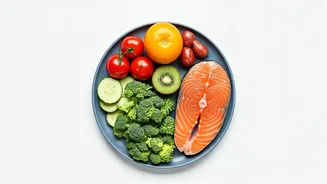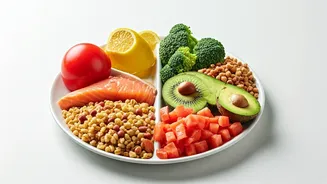Understanding the 9-1 Rule
The 9-1 rule is a straightforward strategy that nutritionists have endorsed to promote weight loss, essentially structuring your dietary intake. It emphasizes
a ratio where the majority of your food choices (9 parts) should be healthy, whole foods, while only a smaller portion (1 part) can include less nutritious options. The beauty of this approach lies in its flexibility and focus on making informed choices rather than complete deprivation. This method acknowledges that indulging in your favorite foods occasionally is permissible as long as the foundation of your diet is built on nutrient-rich selections. By prioritizing whole foods, you ensure you're getting essential vitamins, minerals, and fiber which keep you satiated. This not only aids in weight loss by reducing overall calorie intake, but also promotes overall health and wellbeing. The rule is about creating a sustainable lifestyle, making it easier to stick to your goals long-term and avoid the yo-yo effect often associated with restrictive diets. The key to the success of the 9-1 rule lies in conscious decision-making, encouraging you to reflect on what you eat and to make choices that nourish your body while still allowing for the occasional treat.
Healthy Food Choices (The 9)
The '9' in the 9-1 rule revolves around embracing healthy, unprocessed foods. This means a diet rich in fruits, vegetables, lean proteins, and whole grains. Vegetables and fruits are brimming with vitamins, minerals, and fiber. Fiber keeps you feeling full longer, which helps prevent overeating. Lean protein sources like chicken, fish, beans, and lentils are vital. They keep you satiated, helping you maintain and build muscle mass. Whole grains such as brown rice, quinoa, and oats provide sustained energy and contain valuable nutrients. Portion control is a key aspect of this, focusing on filling your plate with the right balance of these food groups. Aim for a colorful plate where half is filled with vegetables and fruits. A quarter should contain lean protein and another quarter should be whole grains. Preparing your meals at home can give you more control over the ingredients and portion sizes, making it easier to stick to this rule. Consider experimenting with various recipes that feature these food groups, incorporating a variety of tastes and textures to keep your meals enjoyable. This approach helps in building a sustainable eating plan, allowing you to consume what you like but also nurturing your body with the nutrients it needs. Focusing on these foundational elements provides the basis for successful and enduring weight management.
Treats and Indulgences (The 1)
The '1' in the 9-1 rule allows for flexibility, letting you enjoy your favorite foods in moderation. This could include a small serving of a dessert, a portion of processed food, or other treats that you enjoy. The key is to manage these indulgences and not overdo them. Having a small treat will not derail your progress, particularly when the majority of your diet focuses on healthy choices. The principle behind this is to create a sustainable, non-restrictive approach to eating. This helps prevent feelings of deprivation and reduces the likelihood of abandoning your weight loss efforts altogether. Be mindful of portion sizes. Rather than having a large serving, choose a smaller portion and savor each bite. This allows you to indulge without excessive calorie intake. Planning is key. If you know you'll be attending an event where less-healthy foods are available, plan your meals for the rest of the day accordingly, perhaps opting for extra vegetables and lean proteins to compensate. By practicing mindful eating and planning your indulgences, you can stay on track with your weight loss goals without completely restricting yourself. The 9-1 rule empowers you to find a balance, allowing for flexibility while focusing on the long-term well-being and satisfaction.
Simple Weight Loss Tips
Several practical tips can enhance the effectiveness of the 9-1 rule, supporting your weight loss efforts. Drink plenty of water throughout the day. Water keeps you hydrated and can also aid in weight loss by boosting metabolism and making you feel full. Prioritize sleep. Aim for 7–9 hours of quality sleep each night. Sleep deprivation can disrupt hormones that regulate appetite, making it harder to control food cravings. Incorporate regular physical activity. Choose activities you enjoy, whether it's walking, swimming, or dancing, to burn calories and improve your overall health. Reduce stress. Stress can lead to emotional eating. Practice stress-reduction techniques such as meditation or deep breathing exercises. Plan your meals and snacks in advance. This avoids impulsive decisions and ensures you have healthy options readily available. Cook at home more often. This allows you to control the ingredients and portion sizes. Keep a food journal. Track your food intake to become more aware of your eating habits and spot areas for improvement. Be patient. Weight loss takes time. Celebrate small successes and don't get discouraged by setbacks. Focus on developing sustainable habits for lasting results.
Mindful Eating Practices
Integrating mindful eating into your routine greatly complements the 9-1 rule. Mindful eating is all about paying attention to the food you consume, savoring each bite, and listening to your body's signals. Start by eliminating distractions. Turn off the TV, put away your phone, and focus on your meal. Before you start eating, take a moment to appreciate the appearance and aroma of your food. Chew your food slowly and deliberately, noticing the textures and flavors. This helps you to savor your meal and become more aware of when you are full. Pay attention to your body's hunger and fullness cues. Eat when you are hungry and stop when you are satisfied, not stuffed. Avoid eating on autopilot. Be aware of your emotions and how they influence your eating habits. If you find yourself reaching for food when you're stressed or bored, take a moment to understand why and choose a healthier coping mechanism. Practice gratitude for your food and the opportunity to nourish your body. Cultivating mindful eating is a powerful tool to enhance your relationship with food, promote healthier choices, and support your weight loss efforts within the framework of the 9-1 rule.
Customizing the Approach
Adapting the 9-1 rule to suit individual requirements is crucial for optimal results. Tailor the proportion of healthy to less healthy foods to your specific needs and preferences. If you have significant weight loss goals, you might want to consider increasing the emphasis on the '9' by including a wider variety of nutrient-rich foods. If you find it challenging to eliminate all of your favorite treats, gradually reduce the frequency and portion sizes of those foods. This gradual shift can be more sustainable than attempting a drastic overhaul. Consider your activity level. If you are highly active, you might need more calories from a combination of healthy and less healthy sources, as appropriate, to fuel your workouts. Assess your dietary preferences and cultural background. The 9-1 rule can easily accommodate various cuisines and food preferences; the key is to prioritize whole, unprocessed foods within your eating plan. Always listen to your body and adjust the rule accordingly. If you find that the rule isn’t working, consult a nutritionist or healthcare professional for personalized guidance. Remember, weight loss is not a one-size-fits-all approach. Find what works best for you and stay consistent. Customization helps you create a sustainable weight loss strategy.
Staying Consistent Long-Term
Sustaining the 9-1 rule for long-term success involves establishing a set of habits that support your goals. Develop a consistent meal schedule. Eating at regular intervals can prevent overeating and regulate your appetite. Prepare meals in advance. Batch cooking and packing your lunches and snacks can help you avoid impulsive unhealthy choices. Surround yourself with supportive people. Share your goals with friends and family. A support network can help keep you motivated. Find ways to cope with stress that don't involve food. Explore healthy coping mechanisms, such as exercise, hobbies, or meditation, to manage stress effectively. Don’t be too hard on yourself. Setbacks are part of the process. If you slip up, don’t give up. Get back on track with your next meal or snack. Regularly review and adjust your plan as needed. Reflect on your progress. Identify what's working and what isn’t, then make necessary adjustments to keep you on track. Celebrate your achievements. Acknowledge and appreciate your progress along the way to stay motivated. Consistency builds the foundation for long-term results within the 9-1 rule and makes weight management a natural part of your life.
Benefits Beyond Weight Loss
Beyond its contribution to weight loss, the 9-1 rule offers several health benefits. The focus on nutrient-rich whole foods provides essential vitamins, minerals, and antioxidants, which support overall health and vitality. A diet rich in fiber, which is common in whole foods, improves digestion, lowers cholesterol levels, and helps prevent chronic diseases such as type 2 diabetes and heart disease. The emphasis on lean proteins supports muscle growth and maintenance, which can boost metabolism. By incorporating healthy fats, this approach supports brain health and promotes optimal cognitive function. The controlled intake of less healthy foods can reduce cravings and the likelihood of overindulgence, leading to more balanced eating habits. The conscious decision-making encouraged by the 9-1 rule increases awareness of your body's signals, allowing for more mindful eating practices. By adopting these healthy habits, the 9-1 rule promotes enhanced energy levels and improved overall wellbeing. By creating a sustainable dietary pattern, this method improves overall health and quality of life.














